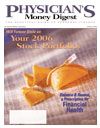Publication
Article
Physician's Money Digest
Treasury Boosts Inflation Bond Yield
Author(s):
Consumers are already feeling Old ManWinter's sharp pinch when paying for oil andgas, but high fuel costs do not stop at thepump. Everything from the price of fruits and vegetablesto fuel surcharges imposed by package deliverycompanies are affected by the consumer price index(CPI), which determines inflation as variations in theprices of all goods and services purchased for consumption.In an attempt to alleviate inflation pressures,the US Department of the Treasury recentlyraised the yield on its Series I Savings Bond (I Bond)from 4.8% to 6.73%.
I Bonds assure consumers a real return rate that isabove inflation, thereby protecting the purchasingpower of your investment. Current I Bond earningscombine a 1% fixed rate of return, applicable up to30 years, with an annualized inflation rate of 5.73%,which is measured by the CPI. Higher energy costspushed consumer prices up 4.7% from a year agoand 1.2% from August to September, the fastestmonthly acceleration in more than 25 years.Earnings rates are adjusted twice per year, and thecurrent 6.73% yield applies to purchases made fromNovember 2005 through April 2006.
State and local income tax exempt, federal incometax on I Bond earnings can be deferred until thebonds are cashed or they stop earning interest. Bondsare unredeemable for the first year, and physician-investorswho redeem a bond within 5 years are subjectto a 3-month earnings penalty.
I Bonds are sold in denominations of $25 onlineand $50 to $10,000 for paper certificates, with a$30,000 annual limit for each form. Anyone whoholds a Social Security number and is a US citizen,resident, or civilian employee can purchase andown I Bonds. Adults can obtain these bonds onbehalf of minors without Social Security numbers,and these gifts do not count toward your annualpurchase limit of I Bonds.
Physician-investors should only allocate 5% to10% of their portfolio to bonds. Although the IBond pays an attractive rate right now, its yield willfall once inflation eases. Be sure to keep in mindthat while the higher fixed rate of return is goodfor the lifetime of the bond, the inflation adjustmentchanges every 6 months. Interested investorscan purchase I Bonds from most banks, creditunions, or savings institutions. Paperless I Bondsand other government bonds are available throughthe US Department of the Treasury at www.treasurydirect.gov.
